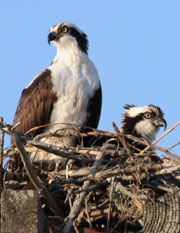19. Babbits Meadows
525 Route 102- Do not proceed beyond the gate with a vehicle

Leave your car in the farmyard and within minutes you will have left behind all evidence of human influence. Walk the riverside fields that are just one turn of the plow blade away from returning to native grasses and sedges regularly flooded by the annual spring freshet. These fields provide migrating shorebirds like Greater Yellowlegs, Common Snipe, and Sandpipers their early treats of aquatic invertebrates, the insects themselves having just awoken from their winter solstice and one long month covered by cold spring waters. Millions of grass seeds floating like an oil slick over the flattened grass are gobbled up by Northern Shovelers, American Widgeon, Mallards, Blue-winged teal, and Black ducks. Warblers hop up and down the steps of alder thickets, disappearing for what seems an eternity, only to reappear when one gives up hope that they may have just seen their first Common Yellowthroat or was it a Yellow Warbler. Warbling Vireos bump across the tree-top branches of elms and silver maples, easily camouflaged by their pale green colour that so closely resembles the soft hues of young leaves. Make your way to the scrub zone that surrounds these seasonally flooded wetlands and you might find a Greater Crested Flycatcher perched in the shade of an ash tree, the purveyor of wood used for the gunnels of the famous Chestnut canoes, built in Oromocto, not too far upriver from here. This site usually has a Northern Water Thrush hanging around for those among you that are ‘listers’!
An old hayfield just ahead is flanked by the incredible Babbitts Meadow to the west and the calming St. John River to the east – a perfect place to spot an Eastern Bluebird or even a Bobolink. You are in a place that is all yours now, but someone is watching too! The majestic raptor perches that line the riverbank and greet you with a calming hand are the famous silver maples of the St. John River. Its tenants are the soaring Bald Eagle and the Osprey. The wetland tucked behind the low ridge of deposited sediment locals call the Intervale forms an integral part of a massive wetland complex that extends upstream for almost four kilometers and measures over 500 acres of wetland habitat. From the intervale you can hear the Salt marsh Sharp-tailed Sparrows singing from quite a distance away, but you will need to get your boots muddy to see a Marsh Wren hopping from one bulrush to the next, or get close to the Black Terns that seem to be flying just over the Wild Rice, tall skinny kids of the marsh hood. Only when you have captured your prized wren in a close encounter and are leaving the marsh with the sun at your back do you spot it – a brilliant but yet indiscrete Red-tailed Hawk, there in plain view in the large maples, waiting to see just how close you will get to his sentinel position.